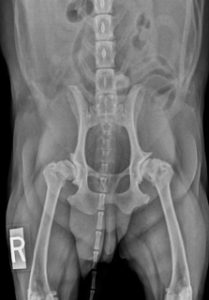Hip dysplasia is a common musculoskeletal condition in dogs, especially in large or giant breeds. It is primarily a genetic disease but it can be amplified by excessive growth, exercise and play habits during puppyhood, obesity, and poor nutrition.
The hip joints are a ball and socket joint. In dogs with hip dysplasia, the joint fails to develop properly, causing rubbing and grinding instead of sliding smoothly. This results in an increased rate of wear and tear.

Hip dysplasia commonly presents in a puppy, sometimes as young as four months old. Occasionally it goes undetected and doesn’t present until 4-5yrs of age. The symptoms are lameness (limping), reluctance to rise or jump, shifting of body weight to the front limbs, loss of muscle mass on the rear limbs especially the bum, and hip pain.
If you or your Vet suspects hip dysplasia, one of the first things they’ll do is perform a physical exam. Your Vet will test the flexibility of the hip joint and manipulate your dog’s hind legs to test the looseness of the joint and to check for any grinding, pain, or reduced range of motion. From here they may suggest x-rays which will confirm the diagnosis and determine the severity of the dysplasia.
If your dog’s hip dysplasia is not severe, or if your dog is not a candidate for surgery for medical or financial reasons, your Vet may recommend a non-surgical approach. Non-surgical approaches may include:
- Weight management to ensure no unnecessary stress is placed on the hips
- Exercise restriction, especially on hard / slippery surfaces
- Rehabilitation including manual therapy
- Medications such as non-steroidal anti-inflammatory drugs (NSAID’s)
If your dog is a good candidate for surgery your Vet may recommend one of the more common procedures such as the Femoral Head Osteotomy (FHO) or Total Hip Replacement (THR). In cases where the dysplasia is diagnosed in a young puppy there may be a minimally invasive option that closes a growth plate in the pelvis and relatively preserves the hip joint. This relies on an early diagnosis which isn’t often possible.
Dogs with hip dysplasia often lead long, full lives, especially with treatment. Most develop hip arthritis however this can generally be managed well with manual therapies, medication, rehabilitation, and lifestyle management. If your dog has been diagnosed with dog hip dysplasia consider booking an appointment to discuss maintenance and how we can help.
Also see the following article on ‘The Hip Flexors and Iliopsoas Strain in Dogs‘ for more about issues around the hips.

